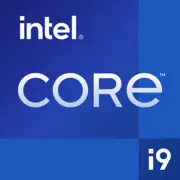Intel Core i9-11980HK

Intel Core i9-11980HK: Power in a Compact Form Factor. A Comprehensive Review of the Flagship Mobile Processor
Introduction
The Intel Core i9-11980HK processor, introduced in 2021, remains a relevant solution for high-performance laptops. Despite the emergence of newer generations (such as Intel Meteor Lake), this model maintains its popularity due to a balanced power-output and compatibility. Let's explore who will benefit from this CPU in 2025 and which tasks it can handle.
1. Architecture and Process Technology: 10 nm SuperFin and Willow Cove
Cores, Threads, and Cache
The Core i9-11980HK is built on the Willow Cove architecture and the 10 nm SuperFin process technology. It features 8 cores with 16 threads, making it ideal for multitasking. The base frequency is 2.6 GHz, with a maximum turbo frequency of 5.0 GHz (for a single core). All cores can boost up to 4.5 GHz with adequate cooling.
Architecture Features
- L3 Cache 24 MB — reduces latency when working with data.
- PCIe 4.0 Support — 20 lanes for fast SSDs and discrete graphics.
- Intel UHD Integrated Graphics for the 11th Generation — 32 EUs (Execution Units), supports 4K@60 Hz, HDMI 2.0b. It delivers 40-60 FPS at low settings for less demanding games (CS:GO, Dota 2).
2. TDP 45W: Power Consumption and Heat Management
Base TDP and Real-World Loads
The nominal TDP of 45W is an average figure. During turbo mode, power consumption can reach 65-85W, requiring an effective cooling system. For example, in the MSI GE76 Raider gaming laptop with two fans and six heat pipes, the processor maintains a stable 4.2 GHz under load.
Dynamic Management
Intel Dynamic Tuning 2.0 technology automatically adjusts power based on the task:
- In office applications, it reduces the frequency to 2.8 GHz to lower heat output.
- In gaming or rendering, it utilizes maximum power but requires active cooling.
3. Performance: From Office Tasks to 4K Rendering
Office and Multimedia
- Geekbench 6: 2071 (single-threaded), 9184 (multi-threaded). For comparison, the Ryzen 9 5900HX scores around ~1950/8900.
- Running 50 tabs in Chrome plus streaming 4K video — no lag.
Gaming
- Paired with an RTX 3080 (laptop version): Cyberpunk 2077 (Ultra, DLSS) — 70-80 FPS at 1440p resolution.
- Turbo mode maintains stable FPS in CPU-intensive games (e.g., Microsoft Flight Simulator).
Professional Tasks
- Rendering a 10-minute video in Premiere Pro (4K, H.265) takes about 12 minutes compared to 15 minutes for the i7-11800H.
- In Blender (BMW scene) — 4 minutes 20 seconds, which is 18% faster than the Ryzen 9 5900HX.
4. Use Cases: Who Needs the i9-11980HK?
- Gamers: For gaming paired with discrete GPUs (RTX 3070 and above).
- Video Editors and 3D Designers: Faster rendering due to 16 threads.
- Streamers: Stream encoding through Quick Sync (hardware encoder built into iGPU).
- VR Users: Thunderbolt 4 support for headset connections.
5. Battery Life: The Price for Power
Battery and Energy Saving
Under light loads (web surfing, office tasks), a laptop with the i9-11980HK and a 90 Wh battery lasts about 5-6 hours. In maximum performance mode — 1.5-2 hours.
Energy Saving Technologies
- Intel Speed Shift: Switching between P-states in microseconds.
- Adaptix Dynamic Tuning: Machine learning for optimizing power consumption.
Tip: Disable Turbo Boost in Windows power settings to extend battery life by 20-30%.
6. Comparison with Competitors
AMD Ryzen 9 5980HX (Zen 3, 8 cores)
- Pros: Better multi-threaded performance (+10% in Cinebench R23).
- Cons: Weaker in single-threaded tasks (-15% in Geekbench 6).
Apple M1 Max (10 cores)
- Pros: 2-3 times better battery life, cool operation.
- Cons: Limited compatibility with Windows software.
Intel Core i9-12900HK (Alder Lake)
- Pros: +25% performance in multi-threaded scenarios.
- Cons: Higher price (laptops from $2200 compared to $1800 for the i9-11980HK).
7. Pros and Cons
Strengths:
- Record single-threaded performance (relevant for gaming and Adobe Photoshop).
- Support for Thunderbolt 4 and Wi-Fi 6E.
- Overclocking capability (in models with unlocked BIOS).
Weaknesses:
- Heating up to 95°C under load (requires regular cleaning of coolers).
- High price of laptops (from $1800 for 2025 models).
8. How to Choose a Laptop with i9-11980HK?
- Gaming Laptop: Look for models with a GPU no less than RTX 3070 and a display of 144+ Hz (e.g., ASUS ROG Strix Scar 15, $1900).
- Workstation: Must have 32+ GB RAM and a 1 TB SSD (Dell XPS 17, $2100).
- Ultrabook: Beware! Thin chassis (e.g., Razer Blade 15) may throttle under sustained loads.
What to Pay Attention To:
- Number of heat pipes (minimum 4).
- Fan operation modes (adjustable via proprietary software).
- Screen matrix: IPS or OLED with 100% sRGB for color correction.
9. Final Conclusion
The Core i9-11980HK in 2025 is suitable for those who need maximum performance in a compact form factor. It is ideal for:
- Gamers, who value high FPS and mobility.
- Professionals, working with 3D graphics and 4K video.
- Enthusiasts, willing to tolerate heat for power.
Key Benefits:
- Best in its class IPC (outperforms even some 12th generation CPUs).
- Flexibility in use: from energy-efficient mode to extreme overclocking.
- Long-term relevance: Support for DDR4-3200 and PCIe 4.0 ensures longevity for 3-4 years.
If you are looking for a "future-proof" laptop and are willing to invest $1800-2500, the i9-11980HK remains a worthwhile option even in 2025.
Basic
CPU Specifications
Memory Specifications
GPU Specifications
Miscellaneous
Benchmarks
Compared to Other CPU
Share in social media
Or Link To Us
<a href="https://cputronic.com/en/cpu/intel-core-i9-11980hk" target="_blank">Intel Core i9-11980HK</a>